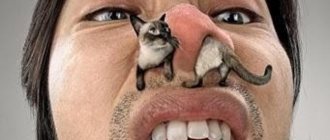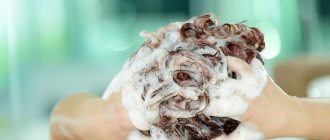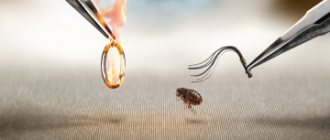The process of peeling off the top layer of keratinized skin occurs constantly, due to the renewal of the epidermis. Excessive accumulation of “scales” on the skin of an animal is called dandruff. Dandruff is a symptom of a pathological condition caused by disruption of the sebaceous glands and characterized by an increase in the rate of detachment of skin particles in the form of scales over a long period of time. The scientific name of this disease is seborrhea. It affects kittens and adult cats of all breeds, regardless of gender.
In the article we will tell you why dandruff appears, what to do when it is detected, how to cure seborrhea by going to the doctor and at home, as well as possible complications of the disease and preventive measures.
Main features
Signs of seborrhea in a cat:
- excessively oily skin under the coat;
- excessive amount of white “scales” of keratinized skin;
- inflammation (redness) of the skin;
- presence of itching.
There are three types of seborrhea:
- dry: “scales” of skin fall off when stroking the fur;
- oily: dandruff does not fall off when combed, the “scales” are glued together;
- mixed type.
Causes of dandruff
There are external and internal causes of the disease.
External ones include:
- Low level of air humidity. Dry air negatively affects the skin of the animal, the skin becomes thick and dry, and dandruff appears. Often accompanied by the appearance of cracks on the paw pads.
- Lack of proper care for the cat's fur and its place of residence, unsanitary conditions. In this regard, fleas, lice and other parasites appear and actively reproduce, causing irritation and itching of the skin. Dandruff can be caused by mites if the animal walks outside.
- The effects of cosmetics and cleaning products on animal fur.
Important! Using shampoo intended for humans may cause allergic reactions on your pet's skin.
- Improper combing of fur. Leads to irritation, scratches and microtraumas of the animal’s skin, which leads to accelerated skin regeneration and the appearance of “scales”.
- Sunburn or excess ultraviolet rays. They lead to accelerated death of epidermal cells and, accordingly, the appearance of dandruff.
- Stressful situations. For example: sterilization, moving to a new place, bringing another pet or child into the house.
- Frequent contact with water. Constant wetting of the skin causes irritation and drying out of the upper layer of the epidermis.
Internal factors:
- Incorrectly formulated diet. It entails a lot of health problems, such as:
- Obesity. If an animal is overweight, it is difficult to care for itself, reaching the back and lumbar area, which is why excess dandruff accumulates in these places.
- Allergic reactions.
Carefully! Allergies can be caused not only by food, but also by chemicals in finished food.
- Problems with the digestive system. They lead to metabolic disorders in the body, which affects the appearance of the cat.
- Vitamin deficiency or excess vitamins. For example, when there is a lack of vitamins A and B in the body, or when there is an excess of them, seborrhea appears.
- Bacterial or fungal diseases. For example, microsporia or lichen lead to skin irritation, constant itching and hair loss in the affected areas.
- Hormonal disorders (hypothyroidism, sex hormone imbalance, Cushing's syndrome). Disturbed metabolism associated with the functioning of the thyroid gland leads to seborrhea.
- Diseases of the musculoskeletal system (arthritis, arthrosis). Pain in the joints when moving prevents the cat from grooming the rump and tail areas, which leads to excessive deposits of “scales” on the skin in these areas.
- Diabetes. A disease associated with insufficient production of the hormone insulin and leading to metabolic disorders, which also affects the animal’s skin.
- Diseases of the urinary system.
- Seborrhea of idiopathic form. This is a hereditary disease characterized by the active secretion of sebum.
- Side effect from drug treatment. Skin reactions occur to medicated shampoo or to taking medications.
Causes of dandruff in cats and kittens
Why does a cat get dandruff? There are many reasons for dandruff on a cat’s back or any other part of the body, let’s look at them.
Dry indoor air and temperature changes.
Lack of humidity in the room where the cat lives can lead to dry skin and, as a result, cause the appearance of dry dandruff. In addition, if a cat stays in a room with dry air for a long time, the skin on the paw pads may crack. Therefore, during the heating season, the air in the room should be additionally humidified, and sudden temperature changes should be avoided.
Fungal infection.
Any fungal infections of the skin (lichen) provoke excessive detachment of skin scales. Ringworm is usually always accompanied by the appearance of dandruff in cats.
Presence of parasites.
The presence of parasites (fleas, ticks) can also lead to dandruff. If left untreated, the vital activity of parasites can cause a malfunction of the animal’s sebaceous glands, and the skin begins to peel off in excessive quantities. Associated symptoms in this case may be redness and irritation of the skin.
Hormonal imbalance in the body.
A malfunction of the thyroid gland, which is responsible for lipid metabolism and regulates the production of sebum, can cause dandruff. And other hormonal imbalances in the animal’s body can provoke disruption of the sebaceous glands and cause the formation of dandruff.
Excess weight.
An overweight cat tends to be less agile and unable to properly groom its coat. She simply cannot reach some areas of the body. Lack of hygiene also causes dandruff.
Allergic reaction.
With dermatitis in cats, foci of inflammation appear on the skin, which are very itchy, and the skin in these areas begins to flake off - dandruff appears. In some cases, dandruff can be caused by an allergy to cat shampoos or grooming products.
Poor nutrition.
Dandruff is often caused by poor diet. An excessive amount of carbohydrates in the diet, a lack of vitamins (especially a deficiency of vitamins A and B) and minerals, the introduction of a new product into the diet - all this can trigger the appearance of dandruff in a cat.
Sunburn.
Aggressive exposure to ultraviolet radiation can damage and dry out the upper layer of the epidermis of a cat's skin, which leads to the appearance of dry dandruff.
Idiopathic seborrhea.
Sometimes the appearance of dandruff in cats is idiopathic. In this case, a hereditary predisposition to the appearance of dandruff in the animal, caused by excessive production of sebum (sebum), is noted. This kind of dandruff is almost impossible to cure; it can only be stopped temporarily with the help of special products and shampoos.
Often cat owners are concerned about the question: can Suprastin cause dandruff in a cat?
The use of Suprastin in the treatment of cats is highly undesirable. Often on forums you can find information about the use of Suprastin as a sedative and sedative during the period of estrus in cats. However, we should not forget that this drug is primarily intended for the treatment of allergies in humans. And it is a strong antihistamine with a side effect manifested in the form of increased drowsiness. But the drug does not have any regulatory effect on the increased hormonal levels of the animal. Therefore, the use of Suprastin in cats (especially during estrus) can lead to unpredictable consequences and even acute poisoning of the animal. This drug will not cause dandruff in a cat, but more global health problems, including those with the nervous system, may arise.
Types of dandruff
Dandruff is distinguished by color and location:
- By color:
- Yellow-white (grains or flakes) is localized on the back and other areas due to allergies, sunburn or malfunction of internal organs.
Black impurities in dandruff
- Black flecks in the fur along with dandruff can be a sign of fungal infections or the presence of parasites.
- By localization:
Internal causes of dandruff
Internal factors include:
- Disruptions in the hormonal system. The thyroid gland is responsible for the functioning of lipid metabolism and acts as a regulator of sebum production.
Disturbances in this system can lead to dandruff. Dandruff may indicate the presence of internal diseases. - Overweight. Overweight cats are unable to properly groom their coats due to reduced activity and clumsiness. They simply cannot reach some areas of the body, such as the lower back and back.
- Allergy. With dermatitis, inflammatory lesions form on the pet's skin, which are accompanied by severe itching and peeling of the skin, resulting in dandruff. In some cases, dandruff can be the result of an allergic reaction to shampoos or skincare products.
- Diseases of the musculoskeletal system. Pain in the joints due to arthrosis and arthritis makes animals inactive, which prevents them from fully caring for the hair in some areas of the body. In such a situation, dandruff in a cat may appear on the tail, lower back and sacrum.
- Poor nutrition. An increased amount of carbohydrates in a pet’s diet, a deficiency of minerals and vitamins A and B, the introduction of a new product to the menu - all this can cause the formation of dandruff in a cat.
- Diseases of the gastrointestinal tract. Metabolic disorders, which accompany many diseases of the digestive organs, lead to focal or local appearance of dandruff.
- Idiopathic seborrhea. When the appearance of dandruff in a cat is idiopathic, it is almost impossible to cure such dandruff. This is due to a hereditary feature - excessive production of sebum.
- Stress, diabetes, diseases of the genitourinary system and medication can also aggravate the development of dandruff.
How to prevent seborrhea
Try to help your pet get rid of the disease yourself using the following methods:
- carry out antiparasitic treatment at home;
- check the air humidity level, you may need a humidifier;
Bathing a cat to treat dandruff
Important! If after carrying out all the above measures the disease progresses, contact your veterinarian.
Prepare in advance the answers to the questions that the doctor will ask you at the appointment to make the correct diagnosis. List of sample questions:
- What is the cat’s diet (main products, diet, amount of food).
- Basic habits and behavioral characteristics of the pet (for example, does it like to lie in the sun, which can cause sunburn).
- How well are hygiene rules observed at home?
- What products and how often do you use when bathing your pet and cleaning the house?
- What vitamin supplements do you give?
- Where and in what conditions does the cat live?
- What was or is you sick with? What medications were used for treatment.
- How do you care for your fur?
After collecting anamnesis, the doctor will prescribe the following tests:
- general blood test and biochemistry;
- blood test for hormones;
- skin scraping;
- inoculation on a nutrient medium and identification of skin culture;
- skin biopsy.
Treatment of seborrhea
Treatment of seborrhea is prescribed comprehensively, it includes:
- prescription of medications;
- changing the diet and composition of food;
- prescription of vitamins (Sherstevit, Phytomins VEDA, Farmavit NEO, Beaphar and others) and food additives containing Omega-3 fatty acids;
- prescribing a course of antifungal therapy and antibiotics for fungal and bacterial infections, as well as retinoids;
- improving the sanitary condition of the room where the cat lives;
- changing the care of the animal's fur;
- use of medicated shampoos;
- use of folk remedies;
- skin massage and proper combing of the coat.
Carefully! At home, treatment of seborrhea can be carried out after consulting a doctor, prescribing special detergents and permission to use traditional medicine.
Effective shampoos for seborrhea include:
- Antifungal and antiseborrheic: “Doctor”, “Veterinary Formula Clinical Care”, “Tea Tree”, SynergyLabs Veterinary Formula Antiseptic & Antifungal, Anju Beauté.
- For fleas and parasites: “Clandestine”, “Bayer Adventage 80”, “Beaphar”, “Fiprex”.
- For ectoparasites: "Lufenuron Oral Suspension For Cats".
- To normalize the functioning of the sebaceous glands: “Biovax”
Complications
Complications of seborrhea may be the following:
- Purulent dermatitis. Occurs in the area affected by seborrhea due to the layering of bacterial flora, usually located on the upper layer of the epithelium and does not cause reactions. Ulcerations form, itching intensifies, and the skin becomes very red.
- Eczema. Redness and itching of the affected area after scratching becomes covered with papules (nodules), in place of which vesicles (bubbles) with liquid appear. Pyogenic bacteria enter places with opened blisters, the wounds become infected and ulcers, ulcers and erosions appear. The skin is constantly inflamed, swollen, raw, and the animal is in pain.
Prevention
Disease prevention measures include:
- Ventilate the room and provide sufficient air humidification.
Omega-3 fats to prevent dandruff
To avoid serious consequences for your pet’s health, carefully monitor its condition and lifestyle, provide proper care and optimal living conditions, and do not neglect contacting an experienced veterinarian at the slightest sign of illness.
The formation of seborrhea, or dandruff, in cats is not so much an annoying external defect in the coat, but rather a serious signal that not everything is in order in the animal’s body. To get rid of pathology, you will need to identify the cause, and then carry out a whole range of measures in different directions. In addition, the owner must be patient and knowledgeable about the characteristics of this disease.
Preventive measures
You can eliminate the risk of unpleasant consequences for your pet. What do you need to do for this?
- Nutrition control : a balanced and varied diet, including fresh foods (vegetables, meat, cereals).
- Regular water procedures : it is necessary to wash your cat, but you should not overuse detergents.
- Controlling humidity in the house: wet cleaning, lack of dust and maintaining cleanliness are an excellent prevention of cat dandruff and hair loss.
- Regular examination by a veterinarian to assess the health of the cat. When the first signs of seborrhea appear in a cat or cat, when the coat becomes oily and unhealthy, timely help is required.
Taking care of the health of your furry pet is a big responsibility for all family members. A defenseless animal cannot help itself, and the main role is given to the owners. Solving a problem is much easier if it is detected in time. Proper treatment will make life easier for a cat or cat and improve their well-being.
We recommend reading: Ringworm From Cats Moves to People
If there are parasitic or fungal diseases, the doctor will prescribe the necessary treatment. Treatment is prescribed similarly for other pathologies of the pet. In case of allergic reactions, cats and kittens are prescribed antihistamines and the source of irritation is excluded.
What type of dandruff does cats have?
There are 3 types of dandruff in felines.
- Dry. It can be shaken off your hands and fur. Gives the animal's hair a dry, dull appearance.
- Fat. May have different thickness. Thus, the “liquid” version is manifested by a pronounced greasiness of the hairs, which are glued together. If you stroke the animal, excess secretion will remain on the palm. With increased density of dandruff (less sebaceous secretion and more skin flakes), it remains in large quantities under the owner’s nails when trying to scratch the pet.
- Mixed. The death of skin cells and the work of the sebaceous glands occur unevenly on the surface of the animal’s body, which leads to alternating dry and oily seborrhea.
Why does dandruff occur in cats?
The causes of dandruff in cats are divided into two categories: external and internal.
- Poor coat care (insufficient quality combing, infrequent washing, unsanitary living conditions, etc.)
- Dry air (dry skin leads not only to seborrhea, but also cracking of the pads of the limbs)
- Ultraviolet rays (accelerate keratinization processes, dry the skin, disrupt heat exchange processes)
- Incorrectly selected animal coat care products
- Stress
- Microtrauma of the epidermis (for example, due to an incorrectly selected comb)
- Frequent bathing (leads to dry skin)
- Allergies (to food, bedding material, parasites, etc.)
- Overweight cat
- Errors in the diet
- Deficiency or excess of vitamins or minerals in food
- Disturbances in the activity of the endocrine system (diabetes, hypothyroidism and others)
- Digestive diseases
- Infections (bacterial, fungal)
- Heredity (idiopathic variant of pathology caused by genes)
- Side effect from taking medications (external or internal)
Cat dandruff. Causes and treatment
Insufficient or improper care, dry air in the room, violations of sanitary standards for keeping the animal, infection with fungi and parasites are external factors. But they can cause dandruff on the cat's back. The most common cause of peeling is the latter option. In the presence of parasites, the skin irritants are toxins that are activated as a result of the release of waste products. Of course, the conditions in which the pet is located depend on the owners, and they have the power to make the environment comfortable without much difficulty.
Monitoring the cleanliness of the surfaces where the cat is, and the entire home in general, maintaining the hygiene of the sanitary area is not at all difficult. After all, it is easier to prevent a disease than to later deal with its consequences, such as, for example, dandruff in cats. The causes and diseases that provoke its appearance can be very different. These include: disruption of the gastrointestinal tract and excretory system of the body, changes in the animal’s hormonal levels, allergic manifestations due to taking medications, the presence of stress, hyper- or hypovitaminosis, and violation of the feeding regime. For example, even introducing a new product into the diet can cause dandruff in a cat. It is almost impossible for the owner of the animal to determine the causes and treatment on his own. It is better to show your pet to a veterinarian, who, first of all, will ask many questions about the living conditions, care products and the cat’s detailed diet.
Diagnosis of dandruff in cats
To cure a mustachioed pet, you need to find out why he has dandruff. And here you cannot do without the help of a veterinarian. At the clinic, the owner will definitely be asked about the cat’s living and feeding habits, favorite habits (for example, he prefers to “sunbathe” in direct sunlight), hygiene products, previous diseases, and so on.
A mandatory item will be the passing of laboratory tests (which ones - at the discretion of the doctor):
- blood for general indicators, biochemistry, hormonal changes;
- taking material from the surface of the skin;
- biopsy;
- cultural research in a nutrient medium and others.
If tests show pathological changes in the animal's body, the veterinarian may order further examination.
Is it possible to determine the cause of dandruff at home?
In the absence of a veterinarian, you can roughly find out what caused dandruff in your cat. For example, if there are light yellow scales on the pet’s body, then such seborrhea can be caused by allergies, UV radiation (from the sun), or a disorder of the internal organs.
Black dandruff is a sign of an infectious disease caused by parasites or fungus. If this symptom occurs, the owner should immediately take the cat to a veterinarian.
If increased shedding of dead skin particles is localized near the tail, it can be assumed that the pet has received a sunburn or has contracted a fungal infection. The same location of seborrhea is observed in felines that are overweight (since it is physically difficult for the animal to reach this area).
Helminth infections, dermatomycosis, joint diseases and other pathologies can lead to dandruff, localized not only in the tail area, but also in the lumbar area. And wandering dandruff (in the form of “tracks”) on the back, face, and paws is often a sign of a subcutaneous mite.
Dandruff in cats and its types
Cat dandruff is a quickly exfoliated top layer of epithelium; its scales are detached as a result of necrosis. In a healthy state, the removal of the upper layers occurs continuously - this is a natural process, since the cells are constantly renewed. If the epithelium dies too quickly, then an illness appears, signaling a pathological process in the animal’s body.
The causes of dandruff in cats and its treatment depend on the type of this phenomenon. There are dry and oily varieties of seborrhea.
Dry scales spread throughout the body, resemble white flour in appearance, they peel off easily and cover the entire coat.
Oily dandruff on a cat's back can be thick or liquid in consistency. Liquid - characterized by the gluing of particles on the back, at the base of the tail, behind the ears. At the same time, the fur itself becomes saggy, looks greasy and dirty, and within a few days after washing it again takes on an unaesthetic appearance. If it’s thick, the particles are practically unnoticeable, but if you scratch your pussy behind the ears, you’ll be left with a greasy mass under your nails.
The shade of the scales is white, beige or yellow (depending on the color of the animal). However, the black color of seborrhea is not the norm even among black felines, this indicates the spread of parasitic microorganisms over the skin. It is not uncommon for a cat to have dandruff and hair growing at the same time.
Why is dandruff dangerous for cats?
Neglected dandruff can lead to complications. One of them is hair loss, up to complete or local baldness. It happens that such places are difficult or impossible to restore in the future. Hair loss occurs due to the fact that dandruff accumulations interfere with gas exchange in the skin, causing disruption of metabolic processes and weakening of hair follicles.
Another complication is purulent inflammation of the skin, reaching the deep layers. The accumulation of dead epidermis serves as an excellent breeding ground for the proliferation of pathogenic microorganisms. Normally, they live on healthy skin, but cannot cause harm due to the good functioning of local immunity. With seborrhea, the immune system weakens, microbes multiply, redness, irritation, and itching occur. As a result of scratching, the infection penetrates even deeper - ulcers, pus, and eczema appear.
How does dandruff appear in cats?
The skin is a very important organ for a cat. It protects the animal from the harmful effects of the outside world and releases metabolic products. The skin is constantly renewed. During the normal process, epidermal cells gradually peel off from the top layer. Sometimes the process begins to occur at an increased speed and dandruff occurs. If dandruff appears in cats, the causes and treatment must be agreed with a veterinarian.
There are several reasons for the formation of dandruff in cats:
- Mistakes in animal care. With a lack of moisture, frequent bathing, spending a lot of time in the sun, an unbalanced diet and a lack of vitamins, the cat's skin becomes dry and tight. Some medications, shampoos and cosmetics for cats can also cause dandruff.
- Allergy. With allergies, the skin turns red, itches, and dandruff forms. An allergen can be: food, household chemicals, hair from other pets, pollen and many other substances.
- Parasites. Fleas, ticks, helminths and other external and internal parasites can be an obvious or secondary cause of dandruff. Fleas living in a cat's fur irritate the skin, epidermal cells slough off faster than usual, and dandruff and itching appear. The cat begins to itch, irritating the skin even more, and the dandruff increases.
- Other reasons. Dandruff can occur with various skin diseases, diabetes, diseases of the digestive system, hormonal changes and other disorders in the body.
Prevention measures
The appearance of dandruff on your cat's fur can be prevented. To do this you will need:
- Brush your pet periodically, especially if it has long hair, and also during shedding;
- prevent the animal from staying in the sun for a long time;
- provide a balanced diet, sufficient amounts of vitamins and minerals;
- when feeding industrial formulations, carefully read the information about the ingredients they contain, avoiding large amounts of allergenic substances (dyes, preservatives, flavors);
- during water procedures, monitor the water temperature, preventing it from increasing;
- buy quality shampoos;
- regularly carry out prevention of internal and external parasites;
- monitor the caloric content of your cat’s food, avoiding excess weight;
- eliminate stress.
When you notice the first symptoms, you must take your cat to a veterinarian. You should not treat dandruff on your own through trial and error.
Sometimes the owner, showing affection to his furry pet, notices that real dandruff has appeared in the cat’s fur. For many, this will be an unpleasant surprise, especially if the animal’s hygiene is observed according to all the rules. Dandruff in a cat looks the same as in humans - the top layer of skin gradually dies, and the scales flake off from the surface of the skin at a certain speed. Sometimes it happens that an excessive amount of dead cells is formed, then white skin particles appear on the fur, and the pet’s appearance becomes unkempt.
What is dandruff?
Dandruff is nothing more than the top scaly layer of the skin, which flakes off too quickly as a result of its necrosis. Shedding of the upper layers of the skin occurs constantly - this is a normal process that promotes cell renewal. When dead cells are formed at an increased rate, naturally, the body tries to get rid of them as quickly as possible, and as a result, “snowflakes” appear on the fur, which cause a lot of trouble for both the cat and its owner.
We recommend reading: Cats and Parasites Transmitted to Humans from Cats
Can cats have dandruff?
Many people are surprised when they hear that cats have dandruff. But if we think based on physiology, then this is a completely common, although not frequent, phenomenon. The processes of skin renewal are constant, and old skin flakes need somewhere to go and they get stuck in the cat’s thick coat. The layer of particles on the wool can be dry or oily. The root cause of the sebaceous layer is often seborrhea.
If the dead horny layer looks like crumbled flour or even snow, then they talk about the dry variety, and with the oily type, the hairs at the base look stuck together and greasy. The type of disease depends on the individual characteristics of each pet’s body.
For some owners, this can be dangerous due to an allergy to cat dander, since a lot of cat saliva remains in the matted fur.
Medicines for cats
Dexafort for cats has proven itself to be an effective, fast-acting drug. The active ingredient is dexomethasone. This is an analogue of cortisol - a hormone produced by the adrenal glands. Dexafort helps with inflammation and allergies and has a calming effect. One time is enough for treatment. The drug is administered intramuscularly.
The anthelmintic Febtal for cats, the price of which depends on the form of release and does not exceed 130 rubles, will help get rid of internal parasites - helminths. The drug Febtal destroys adult parasites, their larvae and eggs, but does not harm the animal. The drug is safe for pregnant and lactating cats. Febtal tablets are given to an animal over three weeks old for three days in a row. The number of tablets is calculated taking into account the weight: per 3 kg of cat weight - 1 tablet.
To prevent dandruff from appearing, pay attention to the animal, keep it clean, feed it with quality food, don’t give parasites any chance, and just love your cat.
Causes of dandruff in cats
There are external and internal reasons for the appearance of particles of dead skin in an animal's fur, which explain why the skin looks untidy.
fungal skin diseases inhibit healthy cells and contribute to their death and exfoliation;
skin parasites such as fleas, ticks, lice eaters. With their vital activity, they cause itching in the cat and, as a result, scratching from the claws exfoliates skin particles even more;
diseases associated with the gastrointestinal tract and others;
diseases of the genitourinary system;
disturbances at the hormonal level;
disorders of the thyroid gland;
allergic reaction of cats to food or environmental factors;
stress, fear, fears;
reaction to certain medications. There are products that promote excessive dry skin. Shampoos that are not suitable for cats can have the same effect;
dietary errors and lack of fatty acids in the diet;
excess weight does not allow the pet to fully care for its fur coat in the back and tail area, so dandruff is often noticeable there.
External causes of dandruff include improper care of the pet: lovers of cat baths may one day be surprised to notice that “snow” is falling from the cat’s fur, or, on the contrary, sticky, unkempt fur has appeared behind the ears and on the back. If you are allergic to the shampoo, this will also be clear from the crumbling skin particles.
Dry air will affect the condition of the coat. If your home is excessively dry, this will soon affect your pet's skin. Sunburn will also make itself felt. No matter how old the animal is, dandruff can easily occur in both an old cat and a tiny kitten.
What is dandruff in cats?
The causes of dandruff in cats can be different. Its appearance can be triggered by both external and internal factors. First, it’s worth finding out what this dermatological disorder is. There are sebaceous glands in the skin that secrete a secretion that forms a microscopic coating on the smooth surface and fur. The sebum layer performs a protective function. When skin regeneration is within normal limits, the peeling off of keratinized scales occurs constantly, but in an amount invisible to the human eye. As soon as peeling becomes obvious, you should pay attention to the health of the animal.
Treating a cat for dandruff
To rid your pet of bran, you need to determine the reason that caused the increased exfoliation of dead skin particles. A small kitten can be very depressed by itching, so the investigation should not be delayed. You will probably have to deal with this for quite a long time: for example, if the cause is dry air in the apartment, then the problem requires a global solution.
Before going to a specialist with a question about how to treat dandruff in a cat , you can independently eliminate the cause of the phenomenon. Negative factors such as improper diet, inappropriate shampoo, and dry air can be easily corrected by owners without the intervention of a veterinarian, and additional drug treatment for back dandruff is not required.
It's worth asking yourself if your cat had something new in her diet after which dandruff was noticed. You can cure the attack by simply excluding the product from the menu.
If shortly before the “snowfall” the pet was given some kind of medicine from skin particles, this must be mentioned to the veterinarian during the examination. The doctor is even informed about procedures such as grooming performed in the salon and the latest treatment for parasites.
If it was not possible to eliminate the disease, then you should not try to become a veterinarian at home without special education: the doctor is much better able to detect a disorder in the cat’s body and prescribe appropriate effective treatment.
Anti-dandruff shampoo for cats
The first thing you should try after adjusting your diet is anti-dandruff shampoo. Such products function as antifungal, antibacterial and normalize the functioning of the sebaceous glands. The main active ingredients are zinc and salicylic acid. Thanks to their effect, the upper layer of skin is regenerated and wounds heal.
The most famous shampoo can be called a product called “Doctor” from TD Goodman. The advantages of the drug include the elimination of unpleasant odor, itching and allergic reactions. The shampoo is easy to foam and rinse off without leaving any residue, leaving the coat looking silky and shiny. If you want to get rid of skin flakes at once, then you should not hope for this - a noticeable effect is achieved in several applications over a long time.
Apply the shampoo to the coat and do not rinse off for 3-5 minutes. At this time, you should distract your pet and not let her try to lick the product.
It would be good if you consult a specialist before using the drug described above.
Professional-level shampoo from Anju Beauté is called super-cleansing. Its action is aimed at normalizing the functioning of the sebaceous glands, as a result the skin is degreased, the secretion of the sebaceous glands is reduced, and the coat itself is moisturized.
The composition contains nettle extract - the cat's coat will grow faster and look much neater and more beautiful.
The product is very economical - for washing it is used in a ratio of 1 to 5 with water.
Vitamins for cats against dandruff
In case of seborrheic revelry on the skin, a vitamin course will not be superfluous:
Cat Felltop Gel with biotin and zinc is great for skin problems;
Cat – Fell OK (Canina) – vitamin and mineral complex with an unlimited course of administration;
Laveta Super for Cats (Beaphar) - thanks to vitamins B, E, biotin and taurine, the coat will become healthy and shiny.
Derm Caps and Derm Liquid is an effective vitamin complex from German developers and is aimed at restoring the skin and improving the health of the coat;
Even the best vitamin complexes will not be able to help if the true cause of dandruff is not eliminated.
Anti-dandruff spray for cats
To treat dandruff in cats, you can use medicated sprays like Tropiclean Oxy-Med. This is a natural remedy with colloidal oatmeal, wheat germ proteins, vitamins B5 and E, and salicylic acid. All substances actively act on the affected area, healing both the skin and coat. Swelling is noticeably reduced and itching is eliminated, and the activity of the sebaceous glands is regulated.
Complications
Fatty particles of dead epithelium are noticeable in the highly shiny coat. And if you don’t look for the reason, the animal’s appearance will be neglected and unkempt. This disease signals problems in the body: leukemia virus, systemic lupus erythematosus, chronic liver disease, drug rash.
An untreated disease also leads to hair loss.
Seborrhea, as a cause of skin peeling, can easily be transmitted from one cat to another, which will also not make owners happy. Therefore, there is no place for thinking here - treat and treat again.
Black dandruff in cats
If the dandruff suddenly turns out to be black, and the color of the animal is also black, you should not calm down, this is not the norm. Particles of peeling skin can be light gray, cream, white, but if they are black, then there is a fungal disease or the presence of parasites in the body.
The cat has dandruff and hair loss
Yesterday my cat was diagnosed with dandruff, and today we noticed that she was shedding a lot of hair - yes, this happens. A cat with dandruff sheds much more, and can even get bald spots from actively trying to scratch its itchy skin.
The veterinarian will give a conclusion whether the cause is parasites, fungus or poor nutrition. In the first two cases, adequate medications will be prescribed, and nutrition will need to be adjusted at home. If the cat ate dry food, then you will have to choose a different type of food for it.
Stray dandruff in a cat
In addition to the usual dandruff, cats also have so-called wandering dandruff, which is caused by the Cheyletiella mite. The disease itself is called cheyletiellosis. The disease, unlike the word, is completely unsightly and extremely contagious for all pets with fur. The mite calmly moves in the keratin layer of the skin, so the dandruff itself, which covers the fur in a thick layer, also moves after the mite. Cheyletiellosis in cats is not difficult to identify: the tick itself can be seen with a good magnifying glass, and the fur looks like a battlefield: there are tracks on the skin everywhere along with a thick rash of skin scales.
Treatment of cheyletiellosis begins with cleaning with a vacuum cleaner, or better yet, with a steam generator, all the nooks and crannies of the home, with washing all bedding, rugs, and carriers. Then the cat begins to be bathed daily using sulfur-based preparations and even includes standard insecticides in the treatment.
Long-haired sufferers are recommended to have their hair cut for a speedy recovery.
Prevention of dandruff in cats
Although the phrase “it is easier to prevent a disease than to treat it” set everyone’s teeth on edge, it remained and will always remain the most faithful advice. The first thing you should do not only for your pet, but also for your own health is to think about the optimal level of air humidity in the apartment. Along with maintaining the humidity level, do not forget about the animal’s constant access to clean, fresh water.
To prevent the formation of creepy-looking, untidy tangles on the fur, clogged with particles of dead skin, the cat is washed with high-quality shampoo in warm, not hot water.
Of course, the presence of parasites in the cat’s life, both inside the body and on the fur, is unacceptable.
For those owners whose cats have access to walking, the advice will be relevant to avoid allowing your pet to stay in the sun for long periods of time.
It remains to add a recommendation for proper nutrition of the purr and the care of the owner, preventing possible stress.










